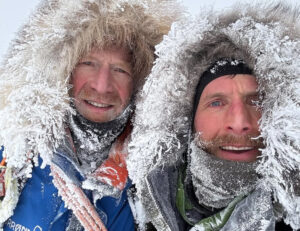Once upon a time, Arctic explorers were so devoted to their goals, whether the attainment of the North Pole, the traverse of the Northwest Passage, or discovering an unknown continent, that they seem like they were suffering from OCD. Not so John Hornby (1880-1927), assuming he can be called an explorer. What he most wanted to do was meet the rough integrity of the Arctic — specifically, Canada’s Barren Lands — with a rough integrity of his own. If that meant hardship or potential starvation, so what?
Born to the realm of English social privilege, Hornby grew up attending lawn parties and going on fox hunts, then attended Harrow School. He soon rejected this background with all his heart and soul. What could be more removed from his family’s capacious mansion Parkfields than an abandoned wolf’s den or a freezing esker, inside both of which he overwintered? And what could be less upper-crust than using a stick instead of toilet tissue when he was traveling? Such actions almost seem like attempts to reduce English pluck to a Monty Python-ish level.
Hornby cut his boreal teeth with such capable northern hands as Cosmo Melville, Guy Blanchet, and George Douglas. Then he began traveling either alone or with hard-bitten Barren Land trappers such as Darcy Arden, whose son told me that “Jack [John] could go farther on a diet of snow and air than anyone else could go on food.”
Wintered inside an esker
Darcy Arden Jr. also told me this story: “My father found Jack digging in the snow near the east arm of Great Slave Lake. He seemed pretty well gone. He told Dad, ‘I’m looking for a wolf skull that I threw out a while back.’ He was going to cook down that skull since he had nothing else to eat. Dad gave him some food and probably saved his life.”
Enter Captain James Critchell-Bullock, with whom Hornby overwintered in 1923 inside the aforementioned esker near Artillery Lake in the Barren Lands. Bullock had been a cameraman in various campaigns in the Middle East during World War I, and he’d brought along $3,000 worth of photographic equipment so he could film this expedition.
Like Queen Victoria, Hornby was not amused. He felt a person should experience life directly rather than with a device like a camera. As a young boy, Darcy Arden Jr. told me that he heard the two of them arguing in a canoe at the outset of their trip. Hornby wanted Bullock to discard his photographic gadgetry, and Bullock refused to do so.
“I was traveling with my dad,” Darcy Jr. said, “and we got so tired of hearing them argue that we paddled away.”
Lost footage
Bullock did shoot some footage of the trip, but he reputedly disposed of it as excess baggage on an island in the Hanbury River during his and Hornby’s arduous retreat on the Hanbury and Thelon Rivers to Baker Lake. In 1996, I happened to be writing up the Hornby/Bullock expedition, and I got in touch with Bullock’s daughter Claudia in England and asked her about the lost footage.
“Funny you should bring this up,” she said. “A month or so ago, we opened an old trunk in the attic, and what should we find inside it but my father’s film. Shall I send it to you?” Not surprisingly, I told her “Yes!”
I was a bit surprised by the film, however. There were no dramatic moments, such as when Hornby and Bullock arrive in Baker Lake at the end of their expedition, and a local Inuk wonders where the blazes this scrawny, disheveled pair has come from.
Instead, there were only brief scenes and stills. A dying wolf turns around in a circle and falls to the ground. One of Hornby’s dogs chases a muskox out of the frame and then reappears, being chased by the same muskox. Hornby himself appears, then dodges out of the frame. The camera focuses on him again, and he dodges out of the frame again. It’s obvious that he didn’t want the sort of attention that most explorers would have craved.

Edgar Christian. Photo: Hornby Archives, Prince of Wales heritage Centre
Last expedition
Accompanied by two greenhorns, his 18-year-old first cousin Edgar Chris-
tian and an explorer wannabe named Harold Adlard, Hornby embarked on his
final Barren Lands expedition in 1926. The destination would be an apparent oasis on the Thelon River that he’d seen on his expedition with Bullock.
In typical Hornby fashion, the trio traveled in such a desultory fashion that they missed the annual caribou migration southward. Likewise, they didn’t bring along a shotgun for killing small game. Thus, Hornby was playing Russian roulette with his life as well as two other lives. But he wouldn’t have used the phrase Russian roulette. Instead, he would have said something like “I can tough out any situation.”
Bullock made the following prescient statement in his diary: “I fancy Jack is destined to give his life to the Canadian hinterlands that he loves so well.” On July 21, 1928, a group of geologists found a rough-hewn cabin on the shores of the Thelon River. Outside the cabin were two bodies, Hornby and Adlard’s. Inside, they found a blanket, and when they unrolled it, Edgar Christian’s skull tumbled out.

The rough-hewn cabin where Hornby took shelter and died. Photo: Hornby Archives, Prince of Wales Heritage Centre
Edgar Christian’s diary
They reported their gruesome discovery to the Royal Canadian Mounted Police, who traveled to the cabin and discovered Christian’s own diary in the stove. The diary, later published as Unflinching, describes the deaths by starvation of each of the three men. In its pages, Hornby emerges as a heroic individual who did his best to save the lives of the other two, even as his own was wasting away.
By now, you’re probably thinking that John Hornby wasn’t so much an explorer as he was simply an oddball. It might be more appropriate to think of him as an environmentalist. For after his expedition with Bullock, he gave Canada’s Department of the Interior a 16-page, single-spaced document requesting that immediate measures by taken to protect the Upper Thelon region from human exploitation.
This document planted the seed for what is now North America’s largest protected wilderness area, the 90,000 square kilometer Thelon Game Sanctuary. In my opinion, Hornby’s act of planting was considerably more important than, say, planting a flag at the North Pole.

The graves of Hornby, Christian, and Adlard. Photo: Hornby Archives, Prince of Wales Heritage Centre
Thanks to Mary Sears at Harvard’s MCZ Library for excavating some obscure tidbits of information about Hornby for me.






